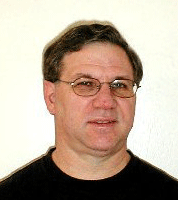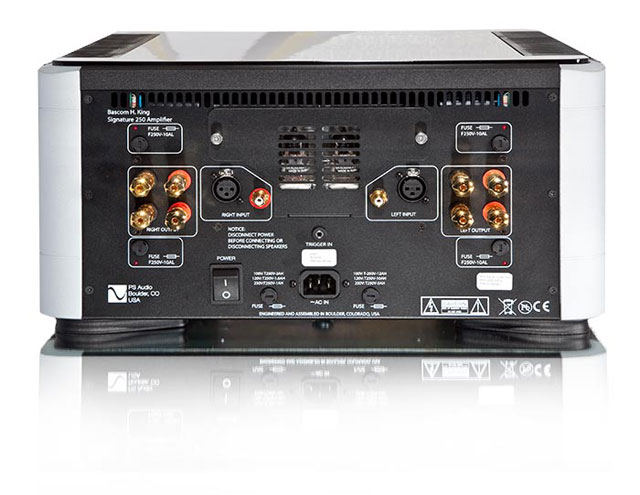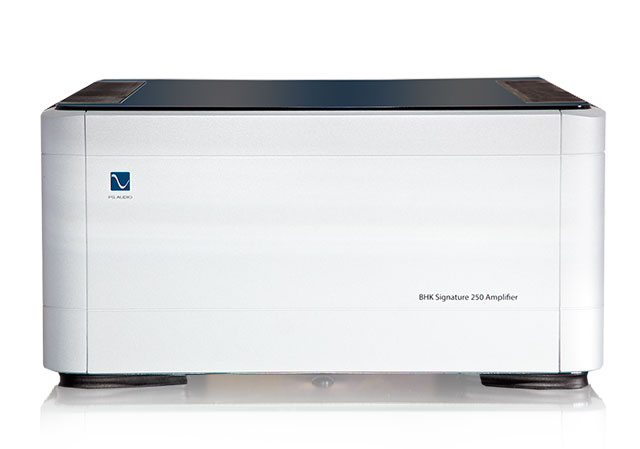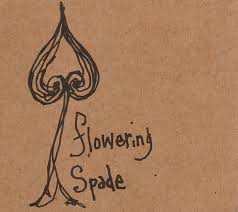PS Audio BHK Signature Stereo 250 Amplifier

PS Audio’s Paul McGowan was fortunate enough to acquire the designing prowess of renowned audio designer and guru Bascom H King to design PS Audio’s top of the line BHK amplifiers. Kudos to McGowan and to Bascom H King!
Until recently, I was content to enjoy the charms of the Rogue Audio ST-100 tube amplifier to drive my Legacy Audio Focus SE speakers full range in my large room’s reference system. But, due to a recent move across town to a larger home, I had two new listening rooms to set up in a large finished basement. Here, the new “Large Room Reference” is approximately 13’Wx22’ long with an 8’ ceiling—large enough for the Focus SE’s to breathe and fill the room with beautiful sound.
And as it happened, that is when I chanced on the opportunity to review the BHK 250 amplifier in my new room! The timing couldn’t have been better!


Features
The BHK 250 amplifier provides the usual features for a basic power amplifier, plus a few more. On the front panel the lighted PS Audio Emblem shows the amplifier is fully on, when lit, and is in Standby when off. The rear panel contains a standard pair of gold-plated RCA-type inputs as well as XLR Balanced inputs that are the preferred hookup. Both black and silver finishes are offered.
Most of the internal high-quality parts are hand soldered onto BHK circuit boards and Bascom King insisted that no surface-mount parts be used in the signal path.
Two pairs of high-quality gold plated speaker binding posts are standard and could work well for bi-wiring if so desired. They are machined out of copper, polished, and then gold plated. There are also a few fuses and a Master on/off switch plus the AC IEC receptacle for use with your power cord of choice. I used a Maker Audio Reference AC cord to power the amp.

Another nice convenience feature is a small hatch plate with a built-in window so you can see the input tubes and easily replace them by removing the hatch plate (instead of the whole top cover). The amplifier comes with a hand matched pair of Russian Gold Lion 6922 input tubes. Free shipping is included in the price as well as a 30-day satisfaction guarantee.
Prelude to Setup, “My Soapbox”!!
I feel it is my duty to explain the need for room correction in a high-end audio system since I’ve been using the Lyngdorf DPA-1 analog/digital pre/pro for the last five or six years.
The reality of getting any audio system to sound great is that you need great performing components and speakers, as well as acoustic tuning devices like bass traps, Room Tunes, diffraction devices (and sure, count your sofa, record albums, and other things in your room as well) to help your listening room support great sound. But if you think that these acoustic measures can nearly fix all your specific room issues I’m afraid you have been seriously misled. Just for example, what are the odds that using tube traps and furniture to control the bass will be adequate? Just so you know, it’s pretty much nearly zero. That is because the bass peaks in your room (or dips) will almost never be at the specific frequencies these acoustic devices work at, and you can count on the bandwidth of the peak and the amount of attenuation being wrong too.
So we’re in the year 2018 now, correct? Then why not use computerized DSP to get you a lot closer to the curve that would actually be of great help in your particular system and room? And heck, if you’re into computer audio and use a media server like the ones from J River Media, then the included graphic and parametric equalization options will allow you to further fine-tune your computer audio appreciably better than the aforementioned acoustic options alone. And using a sophisticated device like a Lyngdorf with RoomPerfect™ or the new Wavelet from Legacy Audio would provide additional flexibility in room control and fine tuning. If you manage to try one of these advanced devices I’m sure you’ll be amazed. End of rant! [Please note that the Lyngdorf DPA-1 has been discontinued but that Lyngdorf is still producing alternative models with RoomPerfect™.]
System Setup
Knowing a little about the design of the BHK 250—6922 tube input stage with a MOSFET output stage and weighty transformers and other high-quality parts under the hood, I expected good things. So after I put another 70 hours of playtime on the amp, I was ready to rock.
I had both the PS Audio DirectStream Memory Player (DMP), and the DirectStream DAC hooked up as well as the Lyngdorf DPA-1 pre-pro with analog and digital inputs plus advanced RoomPerfect™ room correction. And for those of you who may be thinking something like “wow, that’s not fair, he used room correction,” I will note that RoomPerfect™ only knocks down excessive, room induced peaks (very helpful in the bass) and corrects phase issues for improved imaging. And it also provides a “Bypass” button on the remote so I can hear the original unaltered presentation instantly for direct comparison. On several songs I enjoyed the pure sound of the bypass mode, but on most songs I thought the room correction helped a fair amount by maintaining and actually improving the layered imaging and the overall bass linearity in the listening positions. And since I had used the Lyngdorf DPA-1 previously with the Rogue ST-100 tube amp and the same Legacy Focus SE speakers, I was familiar with what it can do and what it does not do. For example, in my view it allows the listener to hear more of what the system electronics and speakers are doing by lessening the negative effects that the room acoustics cause. This is because calibrated microphone measurements are taken in the near field for each speaker and then compared to measurements taken in the listening positions and around the room. Filters are then derived from those measurements.
In addition to my digital sources, I had my modified Michell Orbe SE turntable installed in the same system using an all-tube phono stage from Aural Thrills Audio and a Wilson Benesch ACT 0.5 carbon tone arm with a Benz-Micro low-output Ebony L cartridge. It all worked very well for playing my cherished vinyl.
The Sound of “AWESOME”!!
 So, to begin my serious listening, I put on a few familiar favorites beginning with Regina Spektor’s What We Saw From the Cheap Seats CD (Sire 530373-2). I must say that the BHK amplifier seemed to capture all the emotion and immediacy in Regina’s vocals throughout the album. Songs like “Don’t Leave Me,” and “Firewood” were particularly well served with great layering of the instruments within the vast soundstage, and “All the Rowboats” which is kind of amusing lyrically, exhibited some deep and impactful bass that could not be ignored.
So, to begin my serious listening, I put on a few familiar favorites beginning with Regina Spektor’s What We Saw From the Cheap Seats CD (Sire 530373-2). I must say that the BHK amplifier seemed to capture all the emotion and immediacy in Regina’s vocals throughout the album. Songs like “Don’t Leave Me,” and “Firewood” were particularly well served with great layering of the instruments within the vast soundstage, and “All the Rowboats” which is kind of amusing lyrically, exhibited some deep and impactful bass that could not be ignored.
Then moving on to Patricia Barber’s Companion CD, (Blue Note/Premonition 7243 5 22963 2 3) there was a wonderfully live sounding double bass on Track 2 “Use Me” that made the song pop. And on my favorite (Track 5) “Touch of Trash,” in addition to Barber’s sexy inflective vocal there were some powerful cymbal crashes, sharp clacking drumsticks, and I have to say that the audience sounds at the end of the song were very realistic and enveloped me as if I were attending this live concert. As you might have guessed, “Touch of Trash” is a very LIVE sounding track that effectively brought the concert into my audio room. Great stuff!
 Another great album I used for reference was Sean Hayes’ Flowering Spade (Sean Hayes B0014SZDEU), which has a wealth of wonderful, well recorded songs on it. Playing Hayes’ song “Onion,” the horns sounded great and the brushed cymbals were about as airy and natural as I’ve ever heard them sound. I made a note that said “Inspiring sound—better than live??” so I know it impressed the heck out of me. And on “Sally Ann,” Sean’s vocal was spot-on and the plucked guitar strings couldn’t have sounded more authentic. I really enjoy this album!
Another great album I used for reference was Sean Hayes’ Flowering Spade (Sean Hayes B0014SZDEU), which has a wealth of wonderful, well recorded songs on it. Playing Hayes’ song “Onion,” the horns sounded great and the brushed cymbals were about as airy and natural as I’ve ever heard them sound. I made a note that said “Inspiring sound—better than live??” so I know it impressed the heck out of me. And on “Sally Ann,” Sean’s vocal was spot-on and the plucked guitar strings couldn’t have sounded more authentic. I really enjoy this album!
It is also worth noting that with the BHK 250 amplifier I hear greater differences in recording quality between my various recordings. There are more gradations of quality and as a reviewer and music lover this is something I can truly appreciate.
Caveats
I confess I have no criticism of the BHK 250’s sonic performance—only high praise. It is extended and detailed at both frequency extremes and has an immediate, musical, and open sounding midrange (all qualities I love). That being said, at a hefty 83 pounds net weight, the amp is a bit difficult to move around. So I found a good spot for it and left it there. J
Conclusion
Although the PS Audio BHK Signature 250 stereo amplifier is higher priced than most amplifiers I have used, for an amplifier of this pedigree and obvious premium quality I believe it is quite the bargain at its current $7,499 price tag. In fact, I would seriously consider snapping one up while this price is still available.
It packs quite a wallop and is very powerful, what with its rated 250 watts/channel at 8 Ohms and 500 watts/channel into 4 Ohms. Of course one can always buy the monoblock versions for double the price and get a touch more headroom that way. Paul McGowan believes the monos sound a bit better, but based on my own experience I have to wonder how much better they could possibly sound!
So I think I will just buy this beastie and be thrilled with it! Very highly recommended!


frank Alles
Manufacturer
PS Audio
4826 Sterling Drive
Boulder, Colorado • 80301
800-PSAUDIO • +1-720-406-8946
BHK Signature Stereo 250 Power Amplifier
Dimensions: 17.1” x 8.7” x 15″ deep including connectors.
Weight: 83 pounds
Price: $7,499 USD
Stereo Times Masthead
Publisher/Founder
Clement Perry
Editor
Dave Thomas
Senior Editors
Frank Alles, Mike Girardi, Russell Lichter, Terry London, Moreno Mitchell, Paul Szabady, Bill Wells, Mike Wright, and Stephen Yan,
Current Contributors
David Abramson, Tim Barrall, Dave Allison, Ron Cook, Lewis Dardick, John Hoffman, Dan Secula, Don Shaulis, Greg Simmons, Eric Teh, Greg Voth, Richard Willie, Ed Van Winkle, Rob Dockery, Richard Doran, and Daveed Turek
Site Management Clement Perry
Ad Designer: Martin Perry







Be the first to comment on: PS Audio BHK Signature Stereo 250 Amplifier